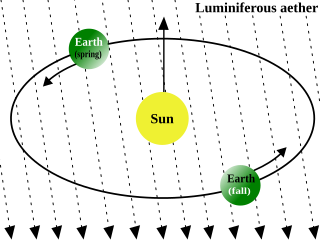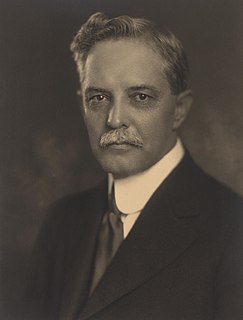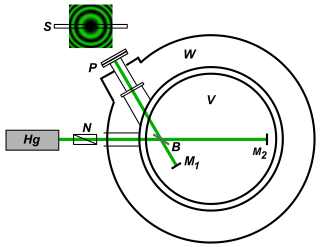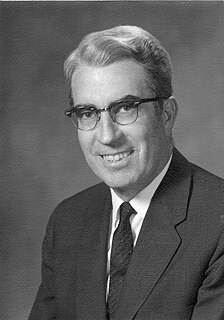
Luminiferous aether or ether was the postulated medium for the propagation of light. It was invoked to explain the ability of the apparently wave-based light to propagate through empty space, something that waves should not be able to do. The assumption of a spatial plenum of luminiferous aether, rather than a spatial vacuum, provided the theoretical medium that was required by wave theories of light.

The theory of relativity usually encompasses two interrelated theories by Albert Einstein: special relativity and general relativity, proposed and published in 1905 and 1915, respectively. Special relativity applies to all physical phenomena in the absence of gravity. General relativity explains the law of gravitation and its relation to other forces of nature. It applies to the cosmological and astrophysical realm, including astronomy.

A cam is a rotating or sliding piece in a mechanical linkage used especially in transforming rotary motion into linear motion. It is often a part of a rotating wheel or shaft that strikes a lever at one or more points on its circular path. The cam can be a simple tooth, as is used to deliver pulses of power to a steam hammer, for example, or an eccentric disc or other shape that produces a smooth reciprocating motion in the follower, which is a lever making contact with the cam. A cam timer is similar, and were widely used for electric machine control before the advent of inexpensive electronics, microcontrollers, integrated circuits, programmable logic controllers and digital control.

The Michelson–Morley experiment was an attempt to detect the existence of the luminiferous aether, a supposed medium permeating space that was thought to be the carrier of light waves. The experiment was performed between April and July 1887 by American physicists Albert A. Michelson and Edward W. Morley at what is now Case Western Reserve University in Cleveland, Ohio, and published in November of the same year.

Albert Abraham Michelson FFRS HFRSE was a German-born American physicist known for his work on measuring the speed of light and especially for the Michelson–Morley experiment. In 1907 he received the Nobel Prize in Physics, becoming the first American to win the Nobel Prize in a science. He was the founder and the first head of the physics departments of Case School of Applied Science and the University of Chicago.

Edward Williams Morley was an American scientist known for his precise and accurate measurement of the atomic weight of oxygen, and for the Michelson–Morley experiment.

Case Western Reserve University (CWRU) is a private research university in Cleveland, Ohio. Case Western Reserve was established in 1967, when Western Reserve University, founded in 1826 and named for its location in the Connecticut Western Reserve, and Case Institute of Technology, founded in 1880 through the endowment of Leonard Case, Jr., formally federated. Case Western Reserve joined the Association of American Universities in 1969.

Dayton Clarence Miller was an American physicist, astronomer, acoustician, and accomplished amateur flautist. An early experimenter of X-rays, Miller was an advocate of aether theory and absolute space and an opponent of Albert Einstein's theory of relativity.

The Kennedy–Thorndike experiment, first conducted in 1932 by Roy J. Kennedy and Edward M. Thorndike, is a modified form of the Michelson–Morley experimental procedure, testing special relativity. The modification is to make one arm of the classical Michelson–Morley (MM) apparatus shorter than the other one. While the Michelson–Morley experiment showed that the speed of light is independent of the orientation of the apparatus, the Kennedy–Thorndike experiment showed that it is also independent of the velocity of the apparatus in different inertial frames. It also served as a test to indirectly verify time dilation – while the negative result of the Michelson–Morley experiment can be explained by length contraction alone, the negative result of the Kennedy–Thorndike experiment requires time dilation in addition to length contraction to explain why no phase shifts will be detected while the Earth moves around the Sun. The first direct confirmation of time dilation was achieved by the Ives–Stilwell experiment. Combining the results of those three experiments, the complete Lorentz transformation can be derived.

The Michelson interferometer is a common configuration for optical interferometry and was invented by the 19/20th-century American physicist Albert Abraham Michelson. Using a beam splitter, a light source is split into two arms. Each of those light beams is reflected back toward the beamsplitter which then combines their amplitudes using the superposition principle. The resulting interference pattern that is not directed back toward the source is typically directed to some type of photoelectric detector or camera. For different applications of the interferometer, the two light paths can be with different lengths or incorporate optical elements or even materials under test.

Robert Sherwood Shankland was an American physicist and historian.
The timeline of luminiferous aether or ether as a medium for propagating electromagnetic radiation begins in the 18th century. The aether was assumed to exist for much of the 19th century—until the Michelson–Morley experiment returned its famous null result. Further experiments were in general agreement with Michelson and Morley's result. By the 1920s, most scientists rejected the aether's existence.
In the 19th century, the theory of the luminiferous aether as the hypothetical medium for the propagation of light waves was widely discussed. The aether hypothesis arose because physicists of that era could not conceive of light waves propagating without a physical medium in which to do so. When experiments failed to detect the hypothesized luminiferous aether, physicists conceived explanations, which preserved the hypothetical aether's existence, for the experiments' failure to detect it.
According to ancient and medieval science, aether, also known as the fifth element or quintessence, is the material that fills the region of the universe beyond the terrestrial sphere. The concept of aether was used in several theories to explain several natural phenomena, such as the traveling of light and gravity. In the late 19th century, physicists postulated that aether permeated all throughout space, providing a medium through which light could travel in a vacuum, but evidence for the presence of such a medium was not found in the Michelson–Morley experiment, and this result has been interpreted as meaning that no such luminiferous aether exists.
In physics, aether theories propose the existence of a medium, a space-filling substance or field as a transmission medium for the propagation of electromagnetic or gravitational forces. Since the development of special relativity, theories using a substantial aether fell out of use in modern physics, and are now replaced by more abstract models.
The Hammar experiment was an experiment designed and conducted by Gustaf Wilhelm Hammar (1935) to test the aether drag hypothesis. Its negative result refuted some specific aether drag models, and confirmed special relativity.

The Fizeau experiment was carried out by Hippolyte Fizeau in 1851 to measure the relative speeds of light in moving water. Fizeau used a special interferometer arrangement to measure the effect of movement of a medium upon the speed of light.

The El Alamein Memorial Fountain is a heritage-listed fountain and war memorial located at Macleay Street in the inner Sydney locale of Kings Cross in the City of Sydney local government area of New South Wales, Australia. It was designed by the Australian architects Robert Woodward and Phill Taranto as employed by architectural firm Woodward and Woodward. The fountain was built from 1959 to 1961. It is also known as El Alamein Fountain, Fitzroy Gardens Group, Kings Cross Fountain and King's Cross Fountain. It was added to the New South Wales State Heritage Register on 14 January 2011. The El Alamein Fountain was commissioned as a memorial to soldiers who died in 1942 during World War II in two battles at El Alamein, Egypt.
Alfred Potier was a French polymath who contributed to many theoretical and practical fields of science when this was rapidly expanding. His interests covered mainly mathematical physics, the nature of light and the ether, geology, electricity and magnetism and their practical applications in industry. His name’s claim to fame rests, however, on a little explored footnote inserted by Michelson and Morley in their famous paper “On the Relative Motion of the Earth and the Luminiferous Ether”.
The Michelson–Morley Award is a science award that originated from the Michelson Award that was established in 1963 by the Case Institute of Technology. It was renamed in 1968 by the newly formed Case Western Reserve University (CWRU) after the federation between the Case Institute of Technology and Western Reserve University. The award continued until 1992, and was re-established in 2002. The award in its various forms is named for physics professor Albert A. Michelson and chemistry professor Edward W. Morley who carried out the famous Michelson–Morley experiment of 1887.














